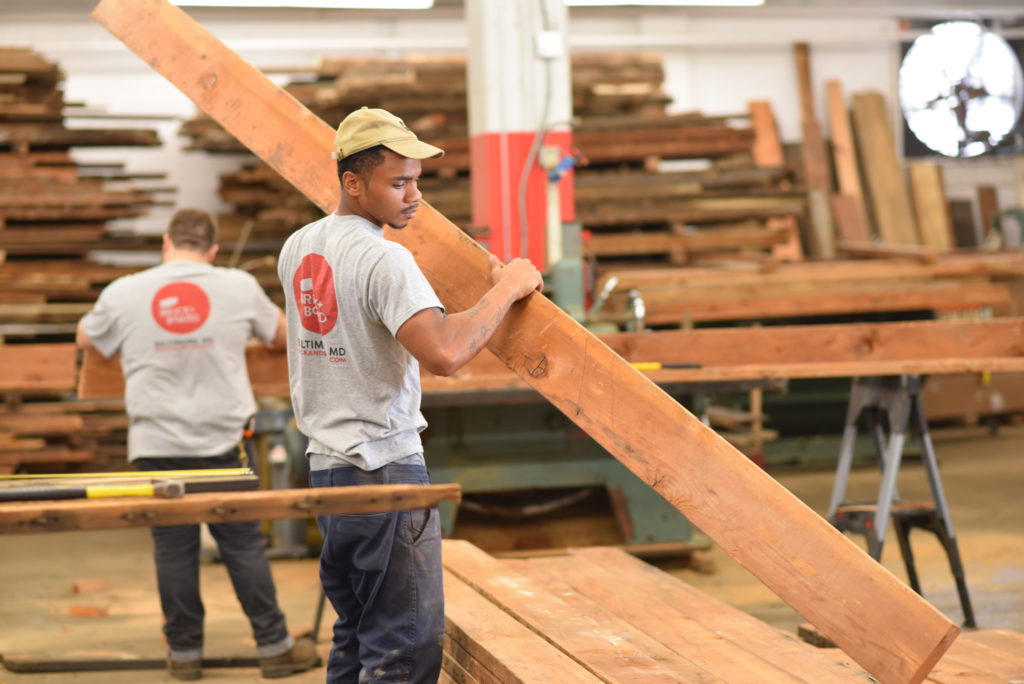
Fred Rogers, creator and host of the long-running television show “Mister Rogers’ Neighborhood,” once wrote: “Often when you think you’re at the end of something, you’re at the beginning of something else.” Mister Rogers was referring to transitions that occur in our lives, but the same idea can be applied to salvaging and reusing urban resources … even the wood in old houses.
Home salvage is explained in a 2007 book by Robert Falk, a research general engineer with the U.S. Forest Service. In “Unbuilding: Salvaging the Architectural Treasures of Unwanted Houses,” Falk says: “As the son of a Depression-era remodeler, my father taught me early on that building materials can live more than one life. … In our resource-rich nation, there’s a wealth of high-quality building material available for salvage. The windows, doors, cabinets, fixtures, lumber, trim and hardwood flooring that often end up in the landfill can all be easily salvaged and reused; and these items can be of much higher quality than those found in new construction.”
While salvage is far from a new idea, it’s catching on in some U.S. cities. Consider Baltimore, a city that has seen its population decline by more than a third since the 1950s – an out-migration that left thousands of vacant houses.
Now, through a four-year initiative called Project C.O.R.E.(Creating Opportunities for Renewal and Enterprise), Maryland is spending millions of dollars to demolish 4,000 of these buildings.
Project C.O.R.E. also creates opportunities to incorporate social and environmental benefits – opportunities that are being addressed through a partnership called the Baltimore Wood Project. Through this partnership, lumber from 1,000 Baltimore rowhomes is being salvaged and repurposed in a way that gives the wood a third life to follow its first two lives: as trees and as construction material.
Driving Sustainability Efforts with Old-Growth Lumber
This lumber is not your everyday wood. Much of it is “old growth,” or lumber from trees that were grown naturally and over hundreds of years. These trees grew slowly due to competition from other trees, which limited the light they received. Because of this slow growth, the growth rings on the trees were packed very tightly together.
By comparison, trees on modern “tree farms” grow quickly, with limited competition from other trees. Tree farm trees are generally harvested just a few decades after they’re planted.
In much of the U.S., old-growth trees were seriously depleted before the early 1900s, so this high-quality wood is hard to find today. Compared to most lumber on the market today, old-growth lumber is more stable, stronger and more resistant to rot and termites. And the boards are often longer and wider than what’s commonly available today.
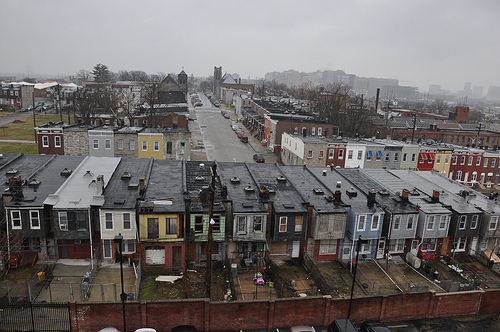
Finding Employment for the Hard-to-Employ
While salvage is more expensive and slower than demolishing homes with backhoes and excavators, it tends to be more environmentally friendly, and it creates jobs. This is where an organization called Humanim comes in. This Maryland-based nonprofit organization employs a local workforce largely made up of people with barriers to employment, such as felony convictions, past addiction or lack of a high school diploma.
In putting these people to work, Humanim trains and equips them with skills that can be used in other jobs. In many cases, they work in struggling neighborhoods where unemployment rates are near 30 percent.
According to Jeff Carroll, director of Humanim’s Details Deconstruction division: “The work itself has really strong environmental and social impact. If you can do it [while] making it an employment vehicle for people who’ve got some challenges getting back into the workplace – now, not only do you have a socially impactful service or product, but you’re doing it in a socially impactful way.”
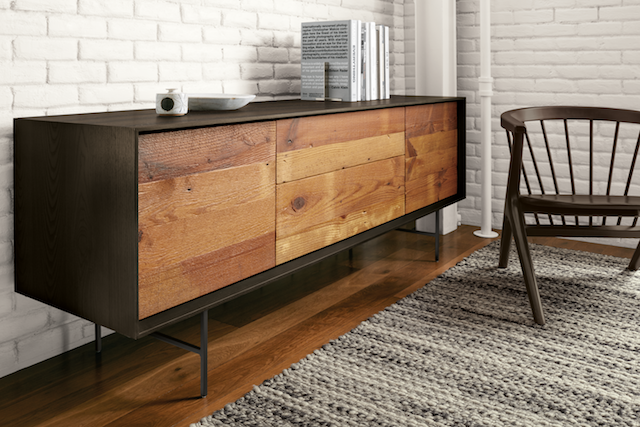
rowhomes. Photo: Room & Board
Putting the Wood to Use
The yellow pine salvaged from Baltimore rowhomes hardly exists anymore, according to Max Pollock, director of Humanim’s Brick and Board division.
“It was overharvested, so only about 3 percent of those old longleaf pine trees remain,” he said. “It grew very tall, very straight and very slow, and it has a nice, rich yellow-orange-amber color. The heartwood has a rich, deep-orange color that sometimes borders on purple; it’s got a tight grain and a great fragrance. And all of it was hundreds of years old when it was cut down to build these houses about 130 years ago.”
The wood’s quality and appearance are just part of the reason why Minneapolis-based furniture manufacturing company Room & Board agreed to repurpose to the wood.
According to Gene Wilson, Room & Board’s director of merchandise and vendor management: “The U.S. Forest Service contacted us about an interesting project: reusing salvaged urban wood. The project has social benefits as well as environmental benefits and we were very intrigued by the opportunity, so we called them back right away.”
So far, Room & Board has created two new product lines that feature salvaged urban wood. One of these, named McKean after a street in Baltimore’s Easterwood neighborhood, is a cabinet that features yellow pine from Baltimore rowhomes. The cabinets have a modern, streamlined style that allows the wood’s natural beauty to stand out.
It’s a fitting product line for a company that’s a founding member of the Sustainable Furnishings Council, a group of organizations committed to making the home furnishings industry more ecologically friendly.
According to Michael Brotman, Room & Board merchandise manager: “The environmental perspective alone is incredible. … I’ve been surprised and shocked in the best possible way. This has the most heart of anything I’ve gotten to work on. Our customers love the story as well as the character of the pieces. We’re looking forward to using the material in new ways.”
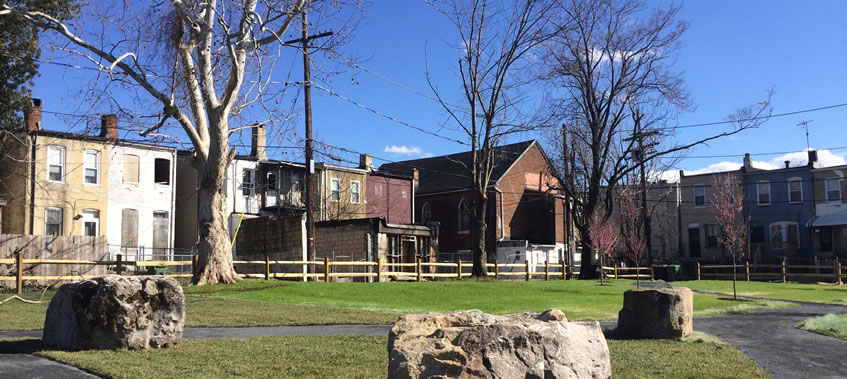
Creating Bright Spots in Underserved Communities
Removal of these buildings provides an opportunity to rejuvenate neighborhoods by turning the properties into community gardens, green spaces, playgrounds and more. In the Easterwood neighborhood, residents hope to use the land for a flower garden, an amphitheater and a farmers’ market.
According to Lauren Marshall, who manages the Forest Service’s Urban & Community Forestry Program, these community spaces can help underserved neighborhoods.
“There’s one park that every time I go there I notice a small improvement, like a Little Free Library box,” she said. “The park is incredibly maintained and clean. You can tell it’s a point of pride in the community.”
What About Fresh-Cut Urban Tree Waste?
For cities that are wondering what to do with wood waste from fresh-cut urban trees and brush, Baltimore has another solution: a wood waste collection program called the Camp Small Zero Waste Initiative.
According to Camp Small yard master Shaun Preston, “We’ve been able to get our logs into local markets to support local businesses: timber and trees for building projects and wood chips for community greening efforts.”
Prior to the initiative, site cleanup at Camp Small used to cost the city about $60,000 per year, but now Baltimore earns revenue from the sale of compost, mulch, wood chips and logs. And although the initiative is just a few years old, there’s plenty of room for growth.
Said Preston, “We’re expanding our program, including getting a sawmill and kiln so we can do some production ourselves in cooperation with local nonprofits.”
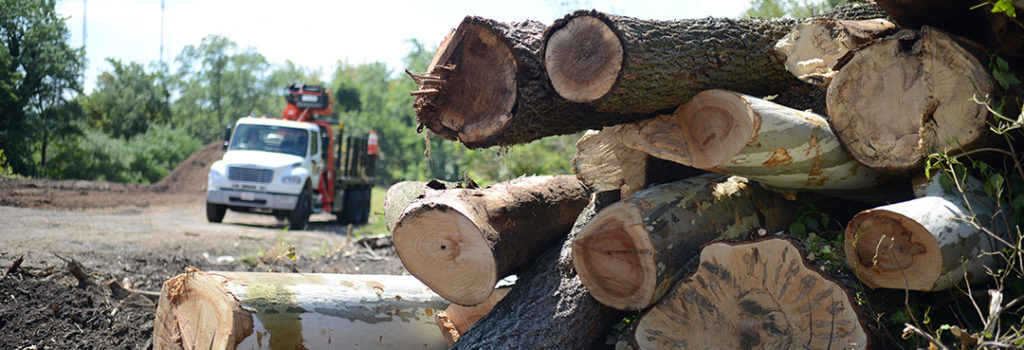
How Stewardship Turned into Salvage
Behind all of these partners is a coordinating agency: the U.S. Forest Service, which is building what it calls an “urban wood and land restoration economy.”
This might seem like a departure from the agency’s stated mission, which is to sustain the health, diversity and productivity of the nation’s forests and grasslands to meet the needs of present and future generations. But when one considers the wood used in these buildings, it could be argued that the Forest Service is merely continuing its stewardship of the nation’s forest resources – more than a century after they were harvested.
According to Morgan Grove, the Baltimore Wood Project lead for the Forest Service’s Baltimore Field Station: “We knew that Baltimore rowhomes were being deconstructed and we also knew we wanted to accomplish several things. We wanted to minimize waste, maximize profit, improve employment and use the land. It was like putting a giant puzzle together, but we’ve found ways to accomplish all of these things using both salvage and fresh-cut material. We’ve found great partners to work with and I think we’ve made positive changes in Baltimore in terms of sustainability and social impact.”
The Next Step: Replicating the Process
About six months ago, the Forest Service brought in a company called Quantified Venturesthat specializes in facilitating social change in the environmental, health, education and workforce development sectors.
For this initiative, Quantified Venture’s directive is to expand and replicate the Baltimore Wood Project. So far, Chicago and Detroit have expressed interest, while managers in other cities are watching closely.
According to Quantified Ventures CEO Eric Letsinger: “We’re taking what was learned in Baltimore and scaling it up massively so it can be used by other cities around the country. When you consider that we throw away as much wood as we deforest in this country and that we can create jobs while we address that issue, it’s certainly a worthwhile cause.”
Brian Cooke is a science and business writer based out of Fort Collins, Colorado. Additional information on his work, clients and other writing samples can be found at www.linkedin.com/in/bcooke1
Making use of “fresh cut urban tree waste” would seem to be a an option worth considering in western cities and suburbs at risk of wildfire. In and around the Bay Area are non native eucalyptus stands that have substantial fuel loads and have replaced native species such as Live Oaks and Bay Laurel trees. Could the large eucalyptus trees be harvested an milled into lumber rather than end up as firewood or in landfills?